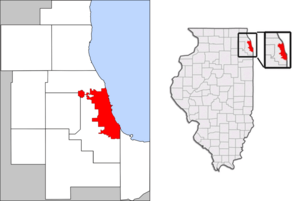 Image via Wikipedia Chicago is the home of the blues and the truth of jazz, the heart of comedy and the idea of the skyscraper. Chicago is the largest city in Illinois. The name "Chicago" is derived from a French rendering of the Native American word shikaakwa, translated as "wild onion" or "wild garlic," from the Miami-Illinois language. The city is a center for business and finance and is listed as one of the world's top ten Global Financial Centers.
Image via Wikipedia Chicago is the home of the blues and the truth of jazz, the heart of comedy and the idea of the skyscraper. Chicago is the largest city in Illinois. The name "Chicago" is derived from a French rendering of the Native American word shikaakwa, translated as "wild onion" or "wild garlic," from the Miami-Illinois language. The city is a center for business and finance and is listed as one of the world's top ten Global Financial Centers.
History in short
In 1803, the United States Army built Fort Dearborn, which was destroyed in the War of 1812 Battle of Fort Dearborn. The Ottawa, Ojibwe, and Potawatomi had ceded additional land to the United States in the 1804 Treaty of St. Louis. The Potawatomi were eventually forcibly removed from their land following the Treaty of Chicago in 1833. On August 12, 1833, the Town of Chicago was organized with a population of around 200 at that time. Within seven years it would grow to a population of over 4,000. The City of Chicago was incorporated on Saturday, March 4, 1837.
Climate
The city lies within the humid continental climate zone, and experiences four distinct seasons. It is a place where the climate has to be taken into consideration. May and September are pleasant and mild; April and June are mostly fine, although thunderstorms with heavy winds can also occur suddenly. Although there may be a slight chill in the air in October, it rarely calls for more than a light coat and some days that's not even necessary. In some years, the warmth stored by the lake may prolong a pleasant autumn into November.
Arrival
Chicago has two major airports, O'Hare International Airport and Midway Airport. There are many taxis from and to city center but they are expensive . They will charge from $30 to $40. CTA trains provide direct service to both larger airports for $2.25
from anywhere in the city. They are faster than a taxi during rush hour and a lot less expensive. Buses and trains are available 24 hours from other major cities.
from anywhere in the city. They are faster than a taxi during rush hour and a lot less expensive. Buses and trains are available 24 hours from other major cities.
Get Around
Navigating Chicago is easy.Standard blocks, of 100 addresses each, are roughly 1/8th of a mile long. (Hence, a mile is equivalent to a street number difference of 800.) Each street is assigned a number based on its distance from the zero point of the address system, the intersection of State Street and Madison Street. A street with a W (west) or E (east) number runs north-south, while a street with a N (north) or S (south) number runs east-west. A street's number is usually written on street signs at intersections, below the street name. CTA (Chicago Transit Authority) operates trains and buses in Chicago. These are considered to be the best way to get around Chicago. Visitor passes are sold for unlimited travel on the CTA and Pace: 1 Day (24 hours) for $5.75; 3 Days for $14; 7 Days for $23 and 30 Days for $86. These passes are on sale at certain train stations, currency exchanges and some convenience stores, and online. Another way is using Metra commuter trains.
See
There are many museums to see in Chicago. The followings are the important places to see in Chicago
Adler Planetarium
ield Museum of Natural History
Shedd Aquarium
Museum of Science and Industry
Art Institute of Chicago
International Museum of Surgical Science
Chicago History Museum
DuSable Museum of African American History
Polish Museum of America
Museum of Photography
Grant Park
Millennium Park
Jackson Park
Washington Park
Chicago is also famous for the events. There are a few can't-miss city-wide events, though. In the Loop, Grant Park hosts Taste of Chicago in July, and four major music festivals: Blues Fest and Gospel Fest in June, Lollapalooza in August, and Jazz Fest over Labor Day Weekend. All but Lollapalooza are free. The Chicago-based music website Pitchfork Media also hosts their own annual three day festival of rock, rap, and more in the summer.




0 comments:
Post a Comment